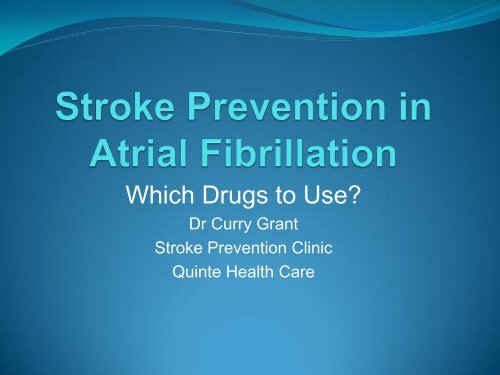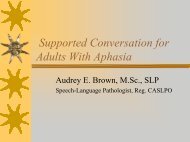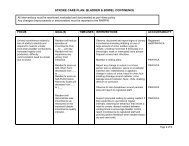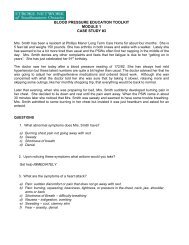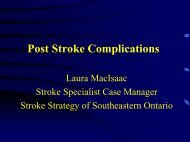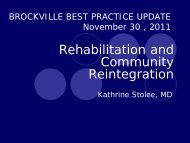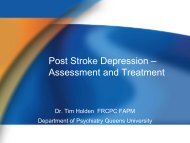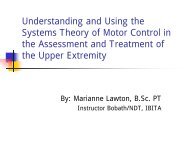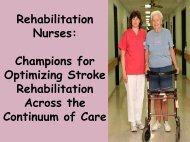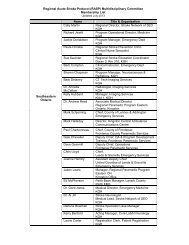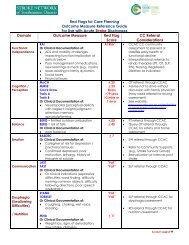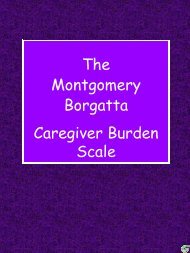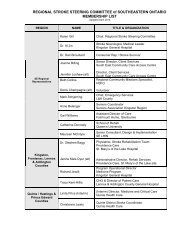Atrial Fibrillation - The Stroke Network of Southeastern Ontario
Atrial Fibrillation - The Stroke Network of Southeastern Ontario
Atrial Fibrillation - The Stroke Network of Southeastern Ontario
Create successful ePaper yourself
Turn your PDF publications into a flip-book with our unique Google optimized e-Paper software.
Which Drugs to Use<br />
Dr Curry Grant<br />
<strong>Stroke</strong> Prevention Clinic<br />
Quinte Health Care
Disclosure <strong>of</strong> Potential for<br />
Conflict <strong>of</strong> Interest<br />
Dr. F.C. Grant<br />
<strong>Atrial</strong> <strong>Fibrillation</strong><br />
FINANCIAL DISCLOSURE:<br />
Support provided by the <strong>Stroke</strong> <strong>Network</strong> <strong>of</strong> <strong>Southeastern</strong> <strong>Ontario</strong><br />
Other: None
Objectives<br />
• Review importance <strong>of</strong> atrial fibrillation in causing<br />
stroke<br />
• Assessing the risk <strong>of</strong> embolic stroke<br />
• Assessing the risk <strong>of</strong> bleeding<br />
• Choosing the best drug for your patient
Causes <strong>of</strong> Ischemic <strong>Stroke</strong><br />
• Large artery atherosclerosis 30%<br />
• Cardioembolic <strong>Stroke</strong> 25-35%<br />
• Small vessel disease 25%<br />
• Unknown 20%<br />
• Unusual causes 5%
Importance <strong>of</strong> <strong>Atrial</strong> <strong>Fibrillation</strong><br />
• ¼ <strong>of</strong> patients over 40 will eventually develop atrial<br />
fibrillation<br />
• Risk <strong>of</strong> stroke averages 5% per year<br />
• Antithrombotic therapy reduces the risk <strong>of</strong> death by<br />
¼ and stroke by 2/3<br />
• Embolic strokes due to atrial fibrillation tend to be<br />
large and to have a high mortality
Approach to <strong>Atrial</strong> <strong>Fibrillation</strong><br />
1. Assess the risk <strong>of</strong> stroke using the CHADS2 Score<br />
2. Assess the risk <strong>of</strong> bleeding using the HAS BLED<br />
Score<br />
3. Possible Choices:<br />
1. Aspirin<br />
2. Aspirin plus clopidogrel<br />
3. Warfarin, apixaban, dabigatran or rivaroxaban<br />
4. Combination antiplatelet plus antithrombotic
Assessing the Risk <strong>of</strong> <strong>Stroke</strong><br />
CHADS2 Score for patients in atrial fibrillation<br />
Risk Factor<br />
Score<br />
Cardiac Failure 1<br />
Hypertension 1<br />
Age 75 or over 1<br />
Diabetes 1<br />
<strong>Stroke</strong> or TIA 2
Annual Risk <strong>of</strong> <strong>Stroke</strong><br />
CHADS2 Score Annual Risk %<br />
0 1.9<br />
1 2.8<br />
2 4.0<br />
3 5.9<br />
4 8.5<br />
5 12.5<br />
6 18.2<br />
0=Very Low Risk<br />
1=Moderate risk<br />
2 or more = Moderate to High Risk
HAS BLED Risk Factors<br />
Risk <strong>of</strong> Bleeding<br />
on Treatment<br />
Hypertension 1<br />
Abnormal kidney or liver function<br />
<strong>Stroke</strong> 1<br />
Bleeding History 1<br />
Labile INRs 1<br />
Elderly Over 65 years 1<br />
Drugs (antiplatelet or NSAID) or<br />
alcohol abuse<br />
Points<br />
1 or 2. One point for each.<br />
Maximum 9 points Low Risk 2 or fewer, High Risk 3 or more<br />
1
HAS BLED Risk Factors<br />
Risk <strong>of</strong> Bleeding<br />
Hypertension 1<br />
Abnormal kidney or liver function<br />
<strong>Stroke</strong> 1<br />
Bleeding History 1<br />
Labile INRs 1<br />
Elderly Over 65 years 1<br />
Drugs (antiplatelet or NSAID) or<br />
alcohol abuse<br />
Points<br />
1 or 2. One point for each.<br />
Maximum 9 points Low Risk 2 or fewer, High Risk 3 or more<br />
1
<strong>The</strong>rapies to Prevent <strong>Stroke</strong><br />
• Antiplatelet Drugs: aspirin, clopidogrel (Plavix),<br />
• Oral Anticoagulant Drugs<br />
• Vitamin K antagonist: warfarin (Coumadin)<br />
• Direct Thrombin Inhibitor: dabigatran (Pradax)<br />
• Factor X inhibitors:<br />
• apixaban (Eliquis)<br />
• rivaroxaban (Xarelto)<br />
• Combinations <strong>of</strong> the above
Drug(s)<br />
Risk <strong>of</strong> Bleeding with A Fib-<br />
Danish Population Study<br />
Annual Risk <strong>of</strong> Bleeding % per<br />
year<br />
ASA alone 3.7<br />
Warfarin 3.9<br />
Clopidogrel 5.6<br />
ASA + Clopidogrel 7.4<br />
Warfarin + Aspirin 6.8<br />
Warfarin + Clopidogrel 13.9<br />
Warfarin + Clopidogrel + Aspirin 15.7
Bleeding on Warfarin ICES<br />
• In patients over 65 years with atrial fibrillation on<br />
warfarin the overall bleeding rate was 3.8% per year<br />
• Highest rates were within the first 30 days<br />
• Increased rates with CHADS2 = 4 or higher<br />
• Mortality from bleeding 18%<br />
• CMAJ 2013 185(2) E121-127
Canadian Cardiovascular Society<br />
• Low risk (CHADS 2 =0)<br />
2012 Guidelines<br />
• No drug, aspirin or oral anticoagulant according to additional risk<br />
factors<br />
• Moderate Risk (CHADS 2 =1)<br />
• Apixaban, dabigatran and rivaroxaban are preferred over warfarin<br />
• Aspirin is an option for some<br />
• High Risk CHADS 2 > 2<br />
• Apixaban<br />
• Dabigatran<br />
• Rivaroxaban<br />
• Warfarin
Apixaban, Dabigatran and<br />
Rivaroxaban<br />
• Approved for non-valvular atrial fibrillation (not for prosthetic valves<br />
or rheumatic heart disease)<br />
• Estimated glomerular filtration rate (eGFR) must be over 30 ml/min.<br />
• Need to monitor renal function periodically<br />
• Caution with previous GI bleeding or coronary heart disease<br />
• Apixaban dose 5 mg BID<br />
• Dabigatran usual dose 150 mg. BID. Reduce to 110 mg. BID with<br />
moderate renal impairment, elderly or small body size.<br />
• Rivaroxaban usual dose 20 mg. daily or 15 mg daily with impaired<br />
renal function
Pharmacology<br />
Drug Dabigatran Apixaban Rivaroxaban<br />
Action Thrombin Xa Xa<br />
T ½ 12-14 hours 12 hours 7-11 hours<br />
Dose 110 or 150<br />
mg. BID<br />
Renal<br />
Excretion<br />
5 mg. BID 15 or 20 mg<br />
OD<br />
80% 25% 33%<br />
Bioavailability 6% 60% 80%<br />
Prodrug Yes No No<br />
Interactions P-gp 3A4 3A4/P-gp
Clinical Trials<br />
Drug Dabigatran Apixaban Rivaroxaban<br />
Trial RE-LY ARISTOTLE ROCKET-AF<br />
Design<br />
Open-Label<br />
Warfarin<br />
Double-Blind<br />
Double-Blind<br />
Participants 18,113 18,206 14,264<br />
A F Risk<br />
Factors<br />
1 or more 1 or more <strong>Stroke</strong>, 2 or<br />
more<br />
Warfarin Naïve 50% 43% 38%<br />
% Time INR<br />
2-3<br />
64 62.2 55
Comparison with Warfarin<br />
Ischemic<br />
<strong>Stroke</strong><br />
Hemorrhagic<br />
<strong>Stroke</strong><br />
Dabigatran Apixaban Rivaroxaban<br />
Better Same Same<br />
Better Better Better<br />
Major Bleed Same Better Same<br />
Mortality Same Better Same
What your patients need to know about<br />
novel oral anticoagulants<br />
1. Compliance is essential. Forgetting 2 or more doses will<br />
leave them unprotected.<br />
2. <strong>The</strong>re is no antidote. If serious bleeding occurs, only<br />
supportive treatment is available at present.<br />
3. If they are on warfarin with a well-controlled INR there is no<br />
need to switch to dabigatran.<br />
4. <strong>The</strong>y should avoid ASA and NSAIDs while on antithrombotic<br />
agents due to the increased risk <strong>of</strong> bleeding.<br />
5. <strong>The</strong>y need renal function tested annually or during acute<br />
illnesses that could impair renal function (creatinine and<br />
eGFR).<br />
6. If not on ODB, the cost is about $100/month.
Dabigatran (431) and Rivaroxaban (435)<br />
ODB Limited Use Criteria<br />
• Inclusion Criteria<br />
• Non-valvular atrial fibrillation CHADS2 = 1 or more<br />
• Inadequate anticoagulation after a trial <strong>of</strong> at least 2<br />
months on warfarin<br />
• Or: warfarin contra-indicated or unable to monitor<br />
INR<br />
• Exclusions:<br />
• eGFR under 30 ml./min.<br />
• Hemodynamically significant valvular heart disease<br />
or prosthetic heart valve
When should warfarin still be used in atrial<br />
fibrillation patients<br />
1. Valvular heart disease<br />
2. Kidney disease with eGFR < 30 ml./min<br />
3. Patients stable on warfarin<br />
4. Patients who cannot afford $3.00 per day<br />
5. Patients on ODB who do not meet criteria<br />
6. Patients in whom the lack <strong>of</strong> an antidote is a<br />
consideration<br />
7. Significant side effects on dabigatran or<br />
rivaroxaban
Case Example<br />
• A 75 year-old lady has had gradually-worsening<br />
fatigue and intermittent palpitations.<br />
• Past history <strong>of</strong> Type 2 DM, hypertension and a nondisabling<br />
stroke<br />
• Meds: ASA, perindopril, HCTZ, metformin<br />
• Physical exam: Pulse 100/min. irregular, BP 140/90<br />
• Lab: eGFR 90 ml./min.<br />
• CHADS2 =<br />
• HAS BLED =
Case Example<br />
• A 75 year-old lady has had gradually-worsening fatigue<br />
and intermittent palpitations.<br />
• Past history <strong>of</strong> Type 2 DM, hypertension and a nondisabling<br />
stroke<br />
• Meds: ASA, perindopril, HCTZ, metformin<br />
• Physical exam: Pulse 100/min. irregular, BP 140/90<br />
• Lab: eGFR 90 ml./min.<br />
• CHADS2 = Hypertension 1 + Elderly 1 + DM 1 + <strong>Stroke</strong> 2<br />
= 5<br />
• HAS BLED= Hypertension 1 + Elderly 1 + <strong>Stroke</strong> 1 = 3
• Warfarin<br />
• Apixaban<br />
• Dabigatran<br />
• Rivaroxaban<br />
Treatment Choices<br />
• ASA + Clopidogrel (for patients who are not<br />
candidates for warfarin, apixaban, dabigatran or<br />
rivaroxaban)<br />
• NB Same bleeding risk as warfarin.
Resources<br />
• Decision Aid by Stephen LaHaye and colleagues at<br />
www.afib.ca and iPad App Afib CDA ($4.99)<br />
• Canadian Cardiovascular Society Guidelines at<br />
www.ccs.ca and iPad App CCS <strong>Atrial</strong> <strong>Fibrillation</strong><br />
Guidelines (Free)<br />
• Canadian Best Practices for <strong>Stroke</strong> Care<br />
www.strokebestpractices.ca
Questions
Ischemic<br />
<strong>Stroke</strong> %<br />
/year<br />
Appendix: Trial Results<br />
Drug vs (Warfarin)<br />
Dabigatran Apixaban Rivaroxaban<br />
.92 (1.2)* .97 (1.05) NS 1.34 (1.42)<br />
NS<br />
Hem. <strong>Stroke</strong> .10 (.38)* .24 (.47)* .26 (.44)*<br />
Major Bleed 3.11 (3.36)<br />
NS<br />
Mortality 3.64 (4.13)<br />
NS<br />
2.13 (3.09)* 3.6 (3.4) NS<br />
3.52 (3.94)* 1.87<br />
(2.21)NS<br />
All Rates are % per year. * = significant. NS=not significant<br />
at .05


